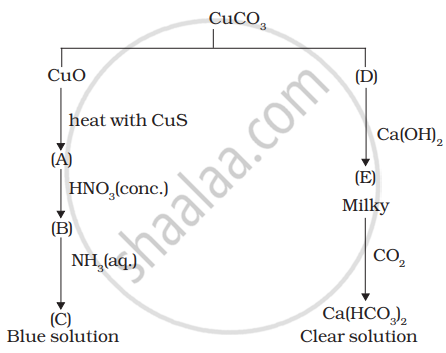Advertisements
Advertisements
Question
Match the properties given in Column I with the metals given in Column II.
| Column I (Property) | Column II (Metal) | |
| (i) | An element which can show +8 oxidation state | (a) \[\ce{Mn}\] |
| (ii) | 3d block element that can show | (b) \[\ce{Cr}\] |
| upto +7 oxidation state | (c) \[\ce{Os}\] | |
| (iii) | 3d block element with highest melting point | (d) \[\ce{Fe}\] |
Solution
| Column I (Property) | Column II (Metal) | |
| (i) | An element which can show +8 oxidation state | (c) \[\ce{Os}\] |
| (ii) | 3d block element that can show upto +7 oxidation state |
(a) \[\ce{Mn}\] |
| (iii) | 3d block element with highest melting point | (b) \[\ce{Cr}\] |
APPEARS IN
RELATED QUESTIONS
What are interstitial compounds?
Interstitial compounds are formed when small atoms are trapped inside the crystal lattice of metals. Which of the following is not the characteristic property of interstitial compounds?
Why is \[\ce{HCl}\] not used to make the medium acidic in oxidation reactions of \[\ce{KMnO4}\] in acidic medium?
A solution of \[\ce{KMnO4}\] on reduction yields either a colourless solution or a brown precipitate or a green solution depending on pH of the solution. What different stages of the reduction do these represent and how are they carried out?
The halides of transition elements become more covalent with increasing oxidation state of the metal. Why?
Assertion: Separation of \[\ce{Zr}\] and \[\ce{Hf}\] is difficult.
Reason: Because \[\ce{Zr}\] and \[\ce{Hf}\] lie in the same group of the periodic table.
Identify A to E and also explain the reactions involved.

Fill in the blanks by choosing the appropriate word(s) from those given in the brackets:
(activation energy, Threshold energy, increased, lowered, partially, full, d-d transition, Benzoic acid, benzaldehyde)
Only those transition metal ions will be coloured which have ______ filled d-orbitals facilitating ______.
Read the passage given below and answer the following question.
|
Are there nuclear reactions going on in our bodies? There are nuclear reactions constantly occurring in our bodies, but there are very few of them compared to the chemical reactions, and they do not affect our bodies much. All of the physical processes that take place to keep a human body running are chemical processes. Nuclear reactions can lead to chemical damage, which the body may notice and try to fix. The nuclear reaction occurring in our bodies is radioactive decay. This is the change of a less stable nucleus to a more stable nucleus. Every atom has either a stable nucleus or an unstable nucleus, depending on how big it is and on the ratio of protons to neutrons. The ratio of neutrons to protons in a stable nucleus is thus around 1 : 1 for small nuclei (Z < 20). Nuclei with too many neutrons, too few neutrons, or that are simply too big are unstable. They eventually transform to a stable form through radioactive decay. Wherever there are atoms with unstable nuclei (radioactive atoms), there are nuclear reactions occurring naturally. The interesting thing is that there are small amounts of radioactive atoms everywhere: in your chair, in the ground, in the food you eat, and yes, in your body. The most common natural radioactive isotopes in humans are carbon-14 and potassium-40. Chemically, these isotopes behave exactly like stable carbon and potassium. For this reason, the body uses carbon-14 and potassium-40 just like it does normal carbon and potassium; building them into the different parts of the cells, without knowing that they are radioactive. In time, carbon-14 atoms decay to stable nitrogen atoms and potassium-40 atoms decay to stable calcium atoms. Chemicals in the body that relied on having a carbon-14 atom or potassium-40 atom in a certain spot will suddenly have a nitrogen or calcium atom. Such a change damages the chemical. Normally, such changes are so rare, that the body can repair the damage or filter away the damaged chemicals. The natural occurrence of carbon-14 decay in the body is the core principle behind carbon dating. As long as a person is alive and still eating, every carbon-14 atom that decays into a nitrogen atom is replaced on average with a new carbon-14 atom. But once a person dies, he stops replacing the decaying carbon-14 atoms. Slowly the carbon-14 atoms decay to nitrogen without being replaced, so that there is less and less carbon-14 in a dead body. The rate at which carbon-14 decays is constant and follows first order kinetics. It has a half-life of nearly 6000 years, so by measuring the relative amount of carbon-14 in a bone, archeologists can calculate when the person died. All living organisms consume carbon, so carbon dating can be used to date any living organism, and any object made from a living organism. Bones, wood, leather, and even paper can be accurately dated, as long as they first existed within the last 60,000 years. This is all because of the fact that nuclear reactions naturally occur in living organisms. |
Which are the two most common radioactive decays happening in human body?
Decide which of the following atomic numbers are the atomic numbers of the inner transition elements:
29, 59, 74, 95, 102, 104
